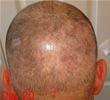Shock loss, also known as telogen effluvium, is a rare condition that occurs after hair transplantation. While it is relatively rare, it does happen in approximately 5% of all patients. A lot of patients mistake shock loss for a botched hair transplant or depleted donor area, but rarely is that the case. In this article, we will be going over the cause of shock loss, how to distinguish shock loss from donor depletion, and finally, what to do to alleviate the appearance of shock loss.
What is Shock Loss?
Shock loss is a chronic shedding of the hair follicle, which causes the appearance of temporary baldness. Shock loss is not specific to any one procedure, because it can occur with Follicular Unit Strip Surgery (FUSS) and Follicular Unit Extraction (FUE). However, shock loss is more commonly seen in the recipient area.
Shock loss occurs from trauma, which can be physical or chemical. Shock loss can occur from extracting FUE grafts with large punches, and large surgical punch-instruments can cause injury to the surrounding hair follicles, causing shock loss. However, shock loss can also occur from excising a strip of hair-bearing tissue from the back and sides of the scalp. The closure of the wound can cause trauma to the hair follicles surrounding the incision, which can cause shock loss.
What's The Difference Between Donor Depletion and Shock Loss?
Visibly speaking, it is difficult to tell the difference between donor depletion and donor shock loss in the beginning. However, some factors can help one determine whether they are suffering from shock loss or donor depletion. The first determining factor should be how many follicular unit grafts are extracted in one surgical session. Anything over 3,500 grafts is extremely and can lead to donor depletion.
Another factor to consider is the timeframe between the surgical procedure and the appearance of thinning. If the thinning appearance occurred within the first 2-3 months after surgery, it is likely due to shock loss. However, if there are no visible improvements after six months, it is probably donor depletion.
How To Deal With Shock Loss
Shock loss can make a quiet procedure that was supposed to be a secret- be as apparent as a pimple with glitter on it. Unfortunately, there isn't much we can do about shock loss, but there are some things that can help improve the recovery of the hair and improve the overall appearance.
STOP Buzzing Your Head!
The first step to recovery is allowing the hair to grow back without cutting it entirely. Unfortunately, the myth that 'buzzing' your head makes your hair look thicker is still alive and well today. If you want to highlight the appearance of thinning, cut your hair short. Nothing will make you look balder than having short hair. The same principle applies to the top of your head and sides.
Use Hair Loss Concealers
Once you allow your hair to grow back fully, invest in hair loss concealers such as DermMatch and Toppik. Toppik is a keratin-based hair fiber that attaches to the hair follicles and makes them thicker and longer. This hair loss concealer will provide a visible boost in density and will block the light from reflecting off of the scalp. DermMatch is a hard-packed powder formula that tints the scalp to reduce the contrast between the color of your hair and your scalp. That said, none of these products will work unless you have at least a few centimeters of hair, so put the clippers down for a few months.
Conclusion
Dealing with shock loss can be a stressful, mentally taxing condition that can easily cause you to become obsessed and checking the mirror every few minutes. It is vital to trust in the process and the hair transplant surgeon. It is crucial to choose a competent surgeon who belongs to a network of pre-screened surgeons who have built their reputation on results, as opposed to advertisements. Don't believe commercial hype. Hair loss forums like the hair restoration network exist.

